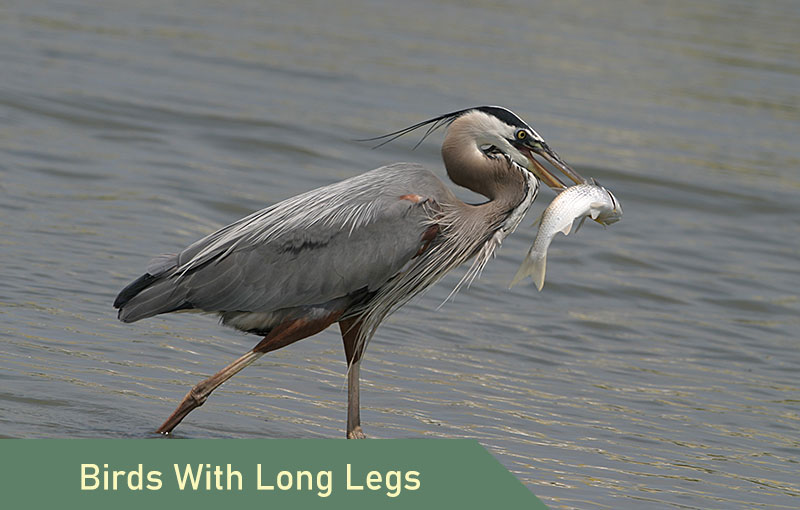
Hello, bird enthusiasts!
Today we’re going to take a closer look at some of the most fascinating creatures in the avian world – birds with long legs. These feathered friends come in all shapes and sizes, from the majestic stork to the colorful flamingo.
Why do birds have long legs?
Birds have long legs for several reasons:
- To wade in water: Some birds, such as herons and storks, have long legs that enable them to wade in shallow water in search of food.
- To reach food: Birds with long legs can reach into taller vegetation to find food more easily.
- For better balance: Birds with longer legs have a larger base of support, which helps them maintain balance while perching or moving around.
- For easier running: Some birds, such as ostriches and emus, have long legs that help them run quickly and efficiently.
- In general, long legs are adaptations that help birds be more successful in their environments by allowing them to access food, move around more easily, and avoid predators.
In this article, we’ll explore the unique characteristics, habitats, and behaviors of birds with long legs. We’ll also discuss the conservation efforts being made to protect these remarkable creatures, some of which are considered endangered species.
So, grab your binoculars and join us as we embark on a journey into the world of birds with long legs. Get ready to be amazed by the beauty and diversity of these fascinating creatures!
On this page
Egrets and Herons – Family Ardeidae
The birds in the Ardeidae family have long legs for several reasons that are advantageous to their survival. Longer legs help them expand their foraging grounds into shallow water without having to get wet. The elevated position also gives them a better vantage point to look for prey or survey surroundings for predators. Their long toes are also beneficial in supporting them on muddy or sandy ground.
Great Blue Heron
Ardea herodias

The Great Blue Heron is a large bird found near wetlands and open water across North America. It has long legs and neck and a daggerlike bill. From a distance, it appears blue-gray with a black stripe over the eye and rust-colored thighs. In coastal southern Florida, there is a pure white subspecies.
Great Blue Herons are solitary and skilled hunters who stalk fish and other prey in shallow water or open fields. They find food by sight and often spear it with their sharp bill. If the prey is too large, they choke it before swallowing it down.
These birds have a unique adaptation to protect their feathers against the grime of their prey and environment.
They have special, continuously growing and fraying down feathers on their chest. When they comb it with the fringed claw on their middle toe, then these feathers break down into a fine powder that they apply to their feathers, which gives them some level of protection.
Little Blue Heron
Egretta caerulea
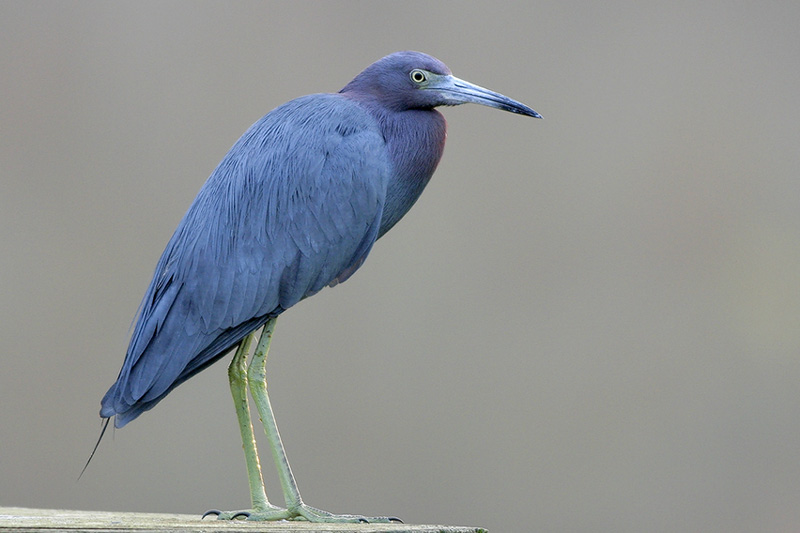
Among herons, the Little Blue Heron is a relatively small species. Adults have a dark overall appearance with a deep purple-maroon head and neck and a dark slaty-blue body which is contrasted by their pale bill and greenish legs. Juveniles are completely white, while molting immatures display a beautiful mix of white and blue.
Due to their white plumage, it can be quite easy to confuse a juvenile Little Blue Heron with other white egret species. However, unlike these energetic hunters, Little Blue Herons are stand-and-wait predators. They patiently observe the water for fish and other small prey and slowly walk or fly to different locations.
This species also has a “comb” on its middle toe, but it’s not as specialized and is used for general grooming.
Tri-Colored Heron
Egretta tricolor
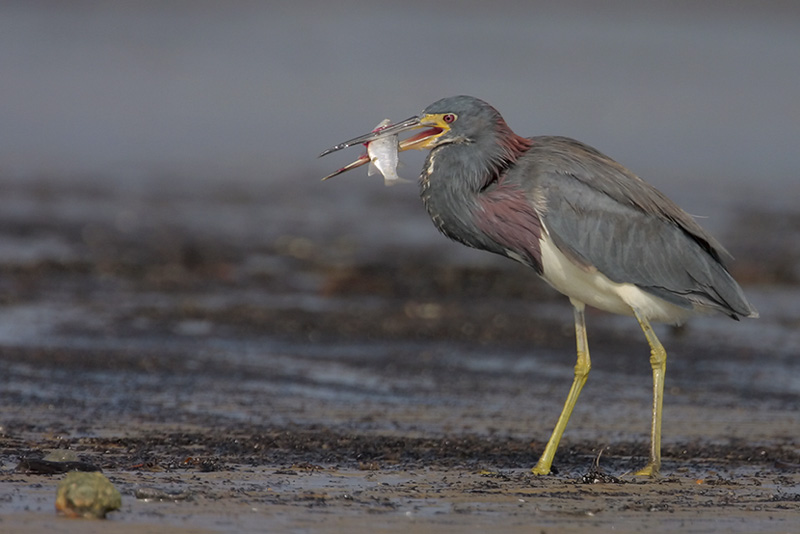
The Tricolored Heron is a fascinating species resident along the east coast of the United States. This medium-sized heron has a slim physique and captivating plumage consisting of blue-gray, lavender, and white.
Juveniles can be recognized by their eye-catching rust-colored necks and feathers on their back and wings. As the younglings get older, they get snappier and parents greet them with gentle bows when returning with food.
When it comes to foraging, Tricolored herons typically prefer to hunt alone or at the periphery of mixed groups of wading birds.
Their hunting technique involves actively stalking their prey by running and often performing stops and turns to keep up.
This active foraging style along with its white belly is helpful when trying to distinguish it from other species.
Great Egret
Ardea alba
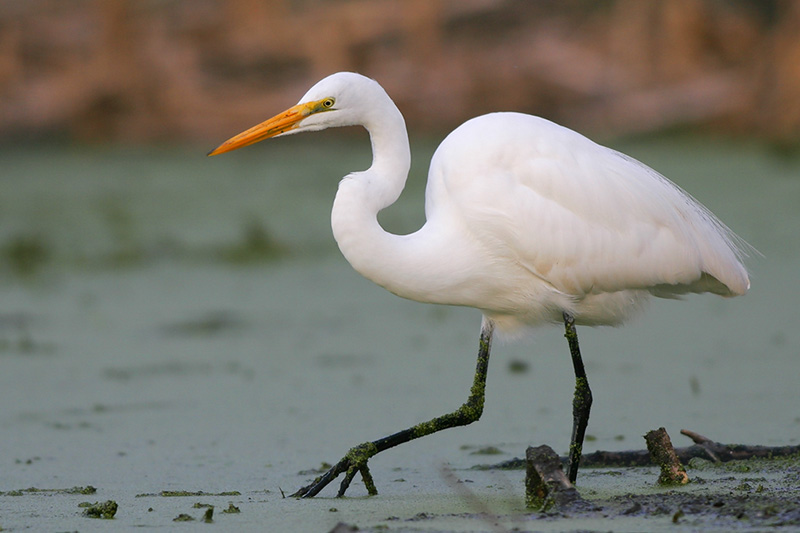
Photograph © Greg Lavaty.
The Great Egret is an elegant bird found in North American wetlands. It has pure white plumage that becomes even more majestic during the breeding season when long white plumes called aigrettes grow from its back. In the late 19th century, these feathers were the reason Great Egrets were hunted and killed.
The Great Egret mainly hunts by standing or walking in shallow water, patiently waiting for fish to approach before swiftly catching them with its bill. Sometimes, it swims to capture prey or hovers over the water and then dips down to catch fish.
This big and elegant bird is also very fierce in nature. Nestlings may kill each other to get more food and they even attack intruders.
Snowy Egret
Egretta thula
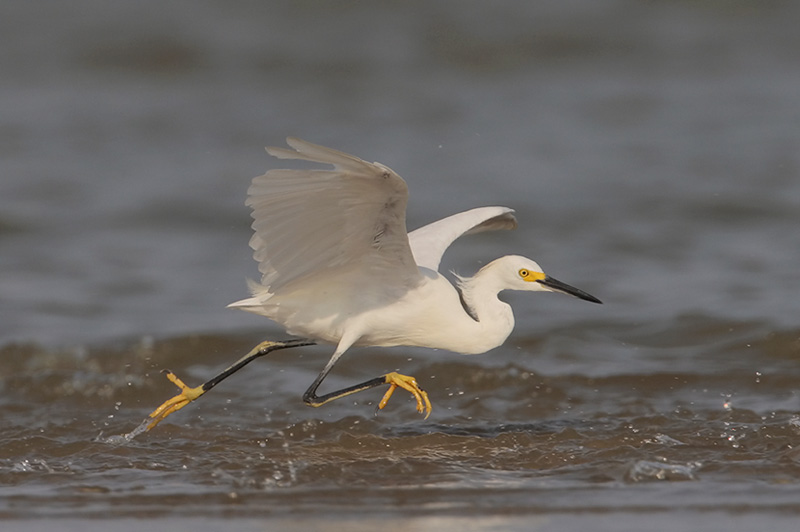
The Snowy Egret is a small white heron with long black legs, bills, and yellow feet. While it may use more patient hunting strategies and stay still, it is on average a quite active hunter.
They run in shallow water, shuffle their feet, sway their head, flick their wings, and vibrate their bill to flush prey out of hiding. Similar to Great Egrets, they may also hover above the water and dip to catch fish.
Occasionally, Snowy Egrets interbreed with other heron species, such as Tricolored Herons, Cattle Egrets, and Little Blue Herons. So if you see a heron but can’t quite put a finger on what species it is even with all the guides out there, it might be a hybrid!
Storks – Family Ciconiidae
Storks, like herons and egrets, have long legs for a variety of reasons related to their natural habitat and feeding habits. They are often found in wetland areas such as marshes, swamps, and shallow waters.
Their long legs enable them to wade through these areas, allowing them to detect and access prey that may be hidden otherwise.
The length of their legs also helps them traverse muddy or uneven terrain, ensuring their stability while foraging.
Wood Stork
Mycteria americana
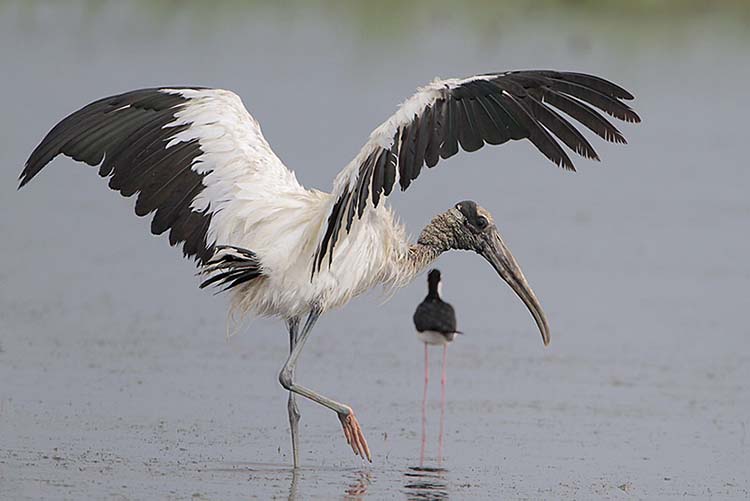
The Wood Stork, formerly known as the wood ibis, is a large wading bird found in the subtropical and tropical habitats in the Americas. It has a white body with black flight feathers and tail, and its dark head is bare and scaly in appearance.
Wood Storks often feed together, wading through wetlands after one another, keeping their heads down, and probing the ground for prey. They can locate prey using touch or sight. During warmer times, when the heat becomes dangerous for the offspring, parents regurgitate water on them to prevent overheating.
Cranes – Family Gruidae
Cranes have long legs that allow them to wade through shallow water without getting wet, navigate through vegetation, and probe into the soil, expanding their foraging opportunities. Many crane species undertake long-distance migrations, and the length of their legs helps to counterbalance their equally long necks when in flight.
Their toes have evolved for a purpose as well. They are long to support their weight on the muddy ground. Interestingly, since cranes build their nests on the ground instead of perching on trees, their back toe has evolved to be tiny. This adaptation prevents the toe from getting trapped in the mire, allowing the cranes to move freely.
Whooping Crane
Grus americana
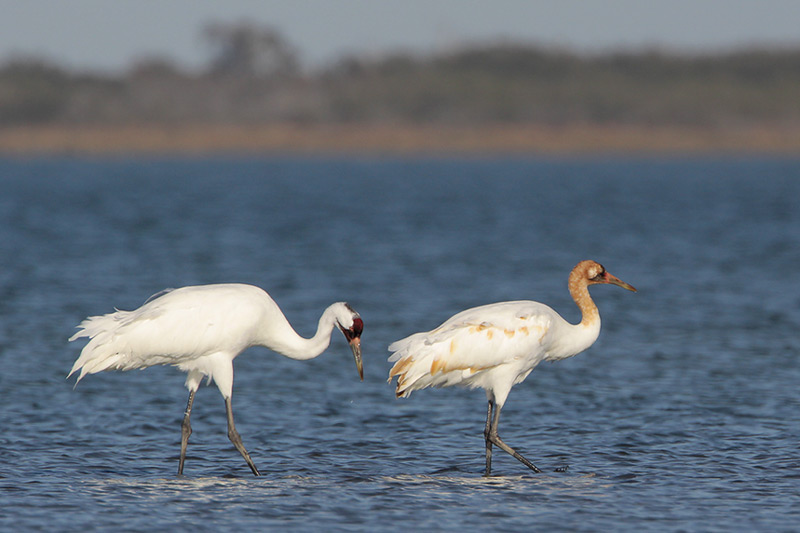
The Whooping Crane is an endangered species that faced a critical decline in population. In 1941, there were a mere 21 individuals remaining. However, thanks to dedicated conservation efforts, their numbers have increased to around 600 today. The only self-sustaining population of Whooping Cranes breeds in Canada and migrates to Texas for the winter.
Standing as the tallest bird in North America, these magnificent creatures are distinguished by their bright white plumage, adorned with touches of red on their heads and black wingtips.
Unlike the patient and stealthy hunting style of herons, Whooping Cranes move at a stately pace while browsing and probing for food.
Their calls are remarkable, emitting loud whooping sounds that can carry over several kilometers.
Due to their substantial size, adult Whooping Cranes have few natural predators in the wild. They can usually deter or avoid attacks by medium-sized predators when they are aware of their presence.
Sandhill Crane
Antigone canadensis
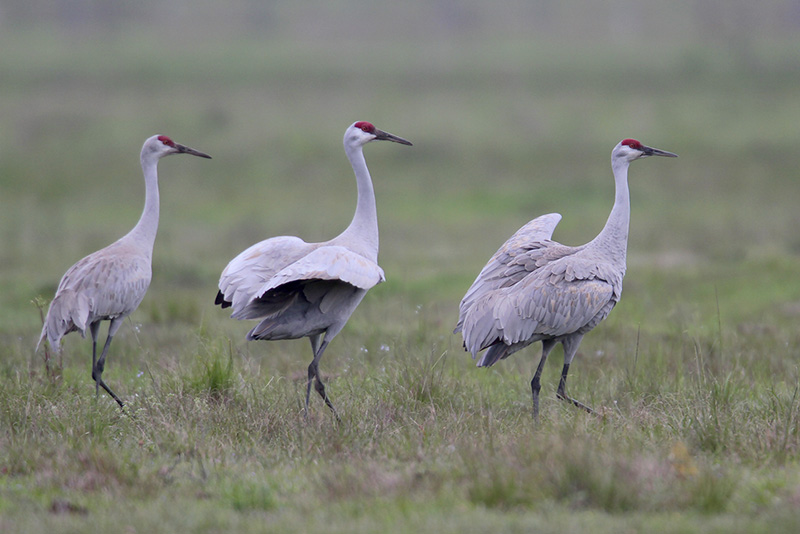
Sandhill Cranes are a common sight in fields, open wetlands, and prairies across North America. These slaty gray birds have pale cheeks, red crowns, and often a rufous wash on their uppersides.
Fairly social in nature, these cranes typically live in pairs or family groups throughout the year and congregate into large flocks during migration and winter.
They often feed together, probing the ground for vegetation and small invertebrates.
Their legs and bills are used not only for foraging but also for defending. When confronted by an aerial predator, they jump and kick them with their feet.
If the predator approaches from the ground, they initially try to chase it away by hissing and spreading their wings but will kick with their feet and stab with their bills if that’s not successful. They can even kill the predator by piercing its skull.
Ibises and Spoonbills – Family Threskiornithidae
Ibises and spoonbills, similar to other long-legged birds, have evolved in a way that would help them survive in their natural habitat. Their long legs allow them to wade through shallow water while keeping their bodies elevated and dry, allowing them to catch aquatic prey and probe the ground underwater without getting wet. They can also better survey their surroundings.
Glossy Ibis
Plegadis falcinellus
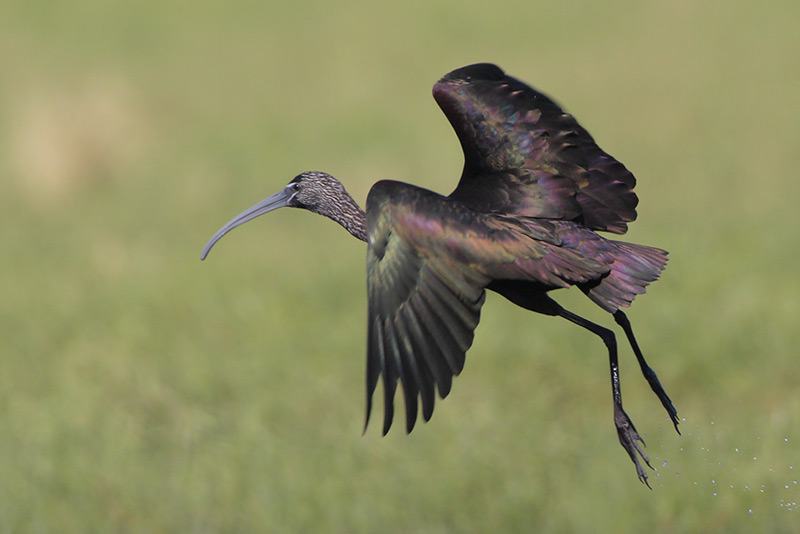
Glossy Ibis
The Glossy Ibis is a captivating bird species that can be found along the east coast of the United States from Maine to Texas.
From afar or in poor light, their appearance doesn’t do them justice – it just looks dark blackish. However, in better conditions, most of its plumage is a beautiful deep maroon complemented by metallic green, violet, and bronze tones on the wings.
These ibises are rather social – they’re colonial nesters and forage in flocks. They wade through shallow water along with other wading birds, slowly advancing and probing muddy areas in close proximity for prey.
White Ibis
Eudocimus albus
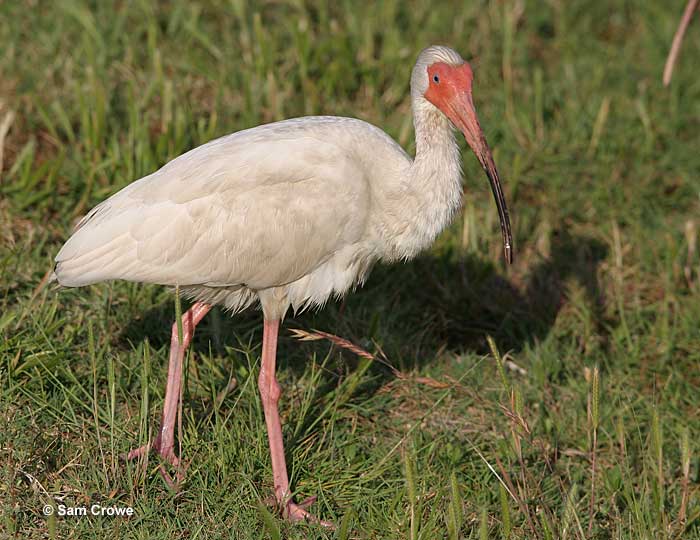
The American White Ibis frequents the shallow wetlands and estuaries of the southeastern United States. The black wingtips and pink legs and downcurved bill provide a beautiful contrast to its otherwise white plumage.
Interestingly, the bills of White Ibis chicks start off straight and only begin to curve downward after they are about 2 weeks old.
These long-legged waders prefer to forage in groups in shallow standing water. With a deliberate and cautious pace, they walk slowly, heads lowered, probing the muddy surface for insects and crustaceans. They are also known to frequent lawns and parks, especially in southern Florida.
Roseate Spoonbill
Platalea ajaja
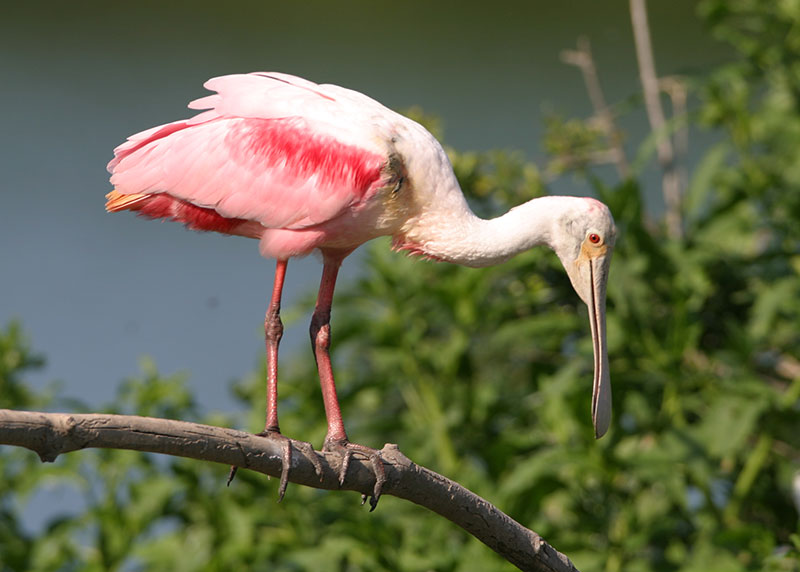
The Roseate Spoonbill is the only spoonbill species in the Americas and can be found in the wetlands, mangroves, forested swamps, and bays from southern Georgia and Florida to Central and South America.
They are known for their remarkable plumage, with colors ranging from pale pink to deep wine red. These same feathers were the reason the species faced a drastic decline in numbers in the 18th and 19th centuries due to excessive hunting.
Roseate Spoonbills use their distinctive spoon-like bills to skillfully capture small prey from shallow water by swishing it back and forth. This technique allows them to sift through the water, feel their prey by touch, and catch it.
Stilts and Avocets – Family Recurvirostridae
Stilts and avocets are shorebirds with long legs for various reasons related to their habitat and foraging habits. They can wade through water without getting themselves wet and their long legs provide a higher vantage point to better detect prey.
American Avocet
Recurvirostra americana
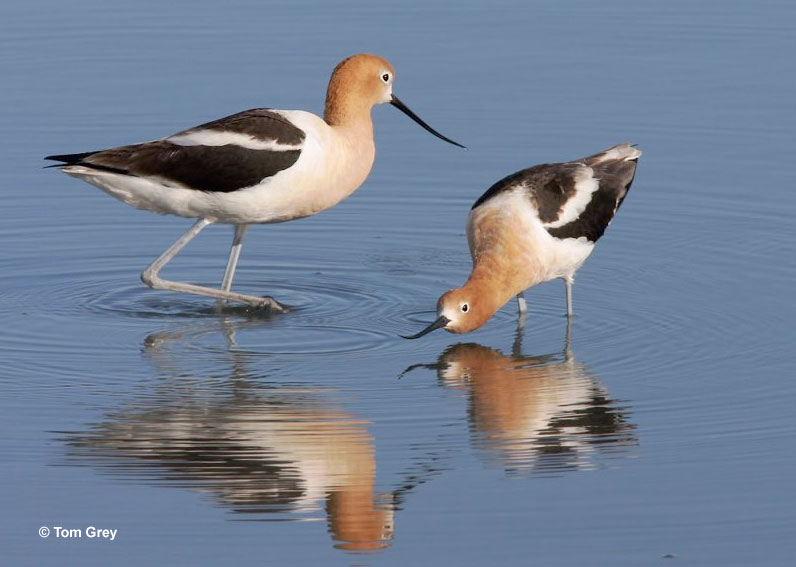
The American Avocet is a slender shorebird with a distinct black, long, and upturned bill. The rusty color on their head and neck gradually transitions into a grayish-white after the breeding season. Otherwise, their black-and-white plumage stays the same year-round.
During the breeding season, these avocets can be found in western North America, while they migrate to the southeastern coast of the United States for the winter. They commonly inhabit various shallow wetland habitats, including salt ponds, impoundments, evaporation ponds, and both fresh and saltwater marshes.
Their foraging technique can help you recognize them. Wading through shallow water, the bird sweeps its bill from side to side, skillfully searching for aquatic invertebrates. Additionally, with each step, it often shakes its foot, effectively removing mud and debris.
Black-necked Stilt
Himantopus mexicanus
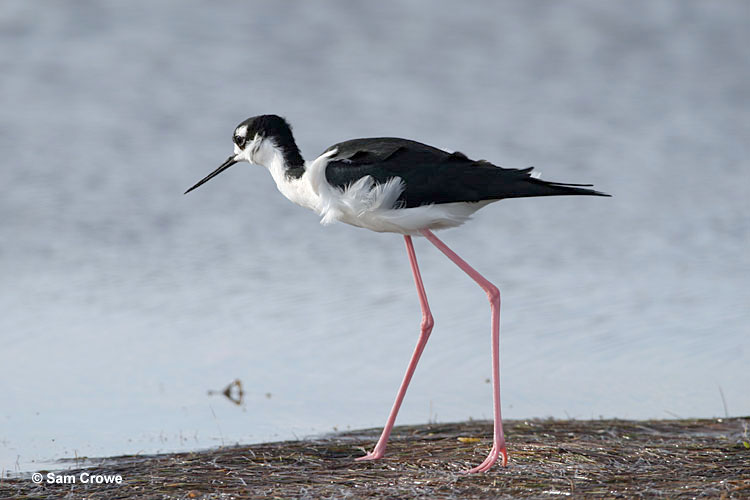
From its incredibly slender stilt-legs to its slim wings and needle-like bill, every aspect of the Black-necked Stilt exudes grace. Its black upper body contrasts with the white underside. They also have a distinctive white patch around the eye.
These stilts are skilled waders, often found near shallow bodies of water, whether they be saltwater or freshwater environments. They rarely swim, preferring to gracefully stride into the shallows in pursuit of tiny aquatic invertebrates.
Their needle-like bills allow them to delicately probe the water’s surface, extracting their prey with precision.
When it comes to defending their offspring and nests, adults usually take to the air, fly around the predator and call at them. They may also feign injury to lure it away from the nest. A group of adults may even gather around a predator and try to chase it away by jumping on it.
Sandpipers – Family Scolopacidae
Sandpipers have long legs for several reasons. Their long legs are an adaptation to their coastal habitats, allowing them to navigate diverse environments such as beaches, estuaries, and mudflats with ease. It also enables sandpipers to wade through shallow water without getting wet.
Thirdly, their long toes provide stability and support for walking on soft sand or muddy substrates. Lastly, the long legs contribute to the sandpipers’ swift movement and agility, helping them quickly navigate their surroundings and evade potential predators.
Greater Yellowlegs
Tringa melanoleuca
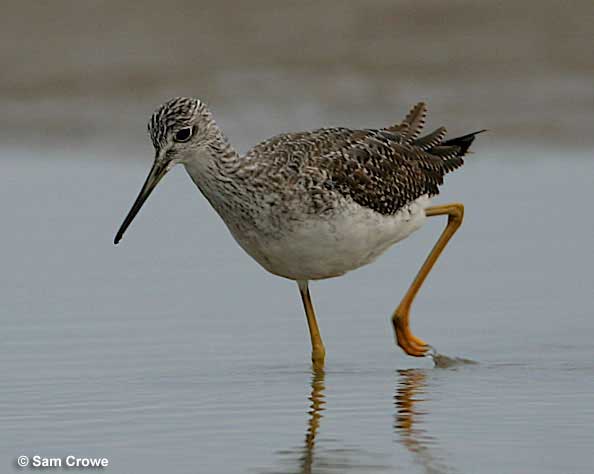
The Greater Yellowlegs inhabit bogs, marshes, and the surroundings of various bodies of water across most of North America. During the breeding season, they establish their nests in the northern regions, while in the winter months, they migrate southward.
Distinguishing features of nonbreeding Greater Yellowlegs include a pale underside and an upperside checkered in dark colors. Breeding individuals have heavily streaked underparts.
These birds are remarkably active foragers. They skillfully explore marshes and mudflats, probing the water and mud for various invertebrates and small organisms. Occasionally, you can see them break into a run to catch their prey.
Lesser Yellowlegs
Tringa flavipes
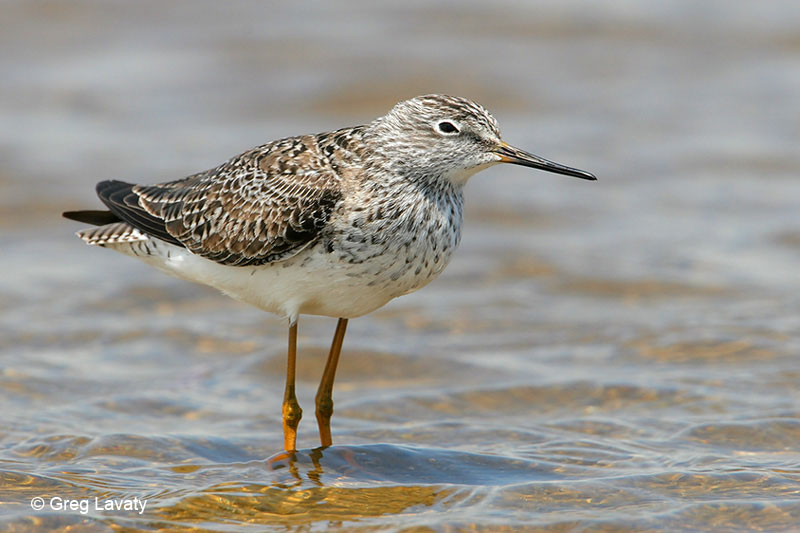
The Lesser Yellowlegs is a fascinating bird species that shares remarkable similarities with its counterpart, the Greater Yellowlegs. Found throughout the Americas, these birds inhabit a variety of habitats, including marshes, mudflats, shores, ponds, and, during the summer, open boreal woods.
Distinguishing characteristics of breeding Lesser Yellowlegs include grayish-brown plumage accompanied by striking yellow legs. In the non-breeding season, their appearance becomes more subdued, with a gray-brown coloration and fewer streaks and spots.
Like the Greater Yellowlegs, they move with a graceful high-stepping gait. These birds typically forage in very shallow water, skillfully picking at items either on the water’s surface or just below it, occasionally swinging their heads back and forth.
In comparison to the Greater Yellowlegs, the Lesser Yellowlegs is frequently spotted in smaller ponds and are known to form larger flocks. Their behavior tends to appear more approachable and less wary.
Long-billed Curlew
Numenius americanus
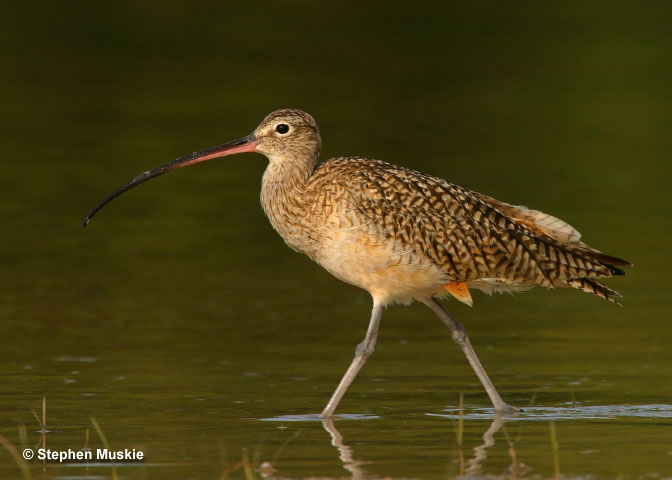
The Long-billed Curlew, also known as the sicklebird or candlestick bird, holds the distinction of being the largest shorebird in North America. It breeds in central and western regions of the continent, migrating southward and coastward for the winter months.
Adults have a pale rust-colored plumage all over with an array of speckles and bars in various shades of brown on their upper body and neck. One of its most notable features is its exceptionally long and curved bill.
They’re very efficient foragers. With a quick-paced walk, it traverses grasslands and mudflats, reaching ahead to pick insects or probe beneath the surface of soft mud or soil for deep-burrowing prey.
Other Characteristics
